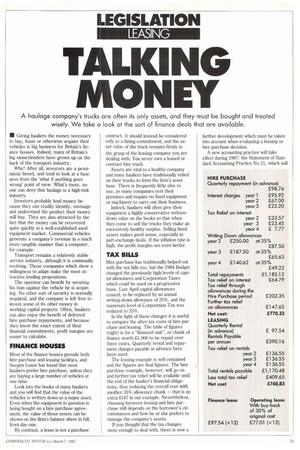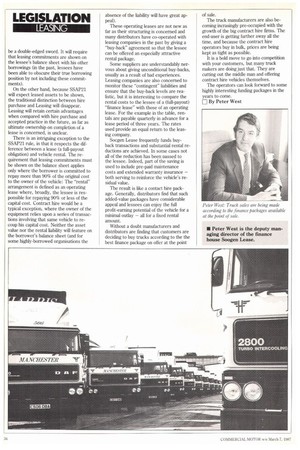TALKING MONEY
Page 35

Page 36

If you've noticed an error in this article please click here to report it so we can fix it.
A haulage company's trucks are often its only assets, and they must be bought and treated wisely. We take a look at the sort of finance deals that are available.
IN Giving hauliers the money necessary to buy, lease or otherwise acquire their vehicles is big business for Britain's finance houses. Indeed, many of Britain's big moneylenders have grown up on the back of the transport industry.
Why? After all, investors are a pessimistic breed, and tend to look at a business from the 'what if anything goes wrong' point of view. What's more, no one can deny that haulage is a high-risk industry.
Investors probably lend money because they can readily identify, envisage and understand the product their money will buy. They are also attracted by the fact that the money can be recovered quite quickly in a well-established used equipment market. Commercial vehicles generate a company's revenue in a much more tangible manner than a computer, for example.
Transport remains a relatively stable service industry, although it is continually evolving. Those companies which show a willingness to adapt make the most attractive lending propositions.
The operator can benefit by securing his loan against the vehicle he is acquiring. No other sort of security is normally required, and the company is left free to invest some of its other money in working capital projects. Often, hauliers can also enjoy the benefit of deferred hire purchase repayments, and because they know the exact extent of their financial commitments, profit margins are easier to calculate.
FINANCE HOUSES
Most of the finance houses provide both hire purchase and leasing facilities, and Socgen Lease has found that most hauliers prefer hire purchase, unless they are buying a large number of vehicles at one time.
Look into the hooks of many hauliers and you will find that the value of the vehicles is written down as a major asset. Even when the equipment in question is being bought on a hire purchase agreement, the value of those assets can be shown on the firm's balance sheet in full, from day one.
By contrast, a lease is not a purchase contract. It should instead be considered only as a hiring commitment, and the asset value of the truck remains firmly in the grasp of the leasing company you are dealing with. You never own a leased or contract hire truck.
Assets are vital to a healthy company and many hauliers have traditionally relied on their trucks to form the firm's asset base. There is frequently little else to use, as many companies rent their premises and require no fixed equipment or machinery to carry out their business.
Indeed, hauliers will often give their equipment a highly conservative writtendown value on the books so that when they come to sell the trucks they make an excessively healthy surplus. Selling fixed assets makes good sense, especially in part-exchange deals. If the inflation rate is high, the profit margins are even better.
TAX BILLS
Hire purchase has traditionally helped out with the tax bills too, but the 1984 Budget changed the previously high levels of capital allowances and Corporation Taxes which could be used on a progressive basis. Last April capital allowances ceased, to be replaced by an annual writing-down allowance of 25%, and the maximum level of Corporation Tax was reduced to 35%.
In the light of these changes it is useful to compare the after-tax costs of hire purchase and leasing. The table of figures (right) is for a "financed unit", or chunk of finance worth £1,000 to be repaid over three years. Quarterly rental and repayment charges payable in advance have been used: The leasing example is self-contained and the figures are final figures. The hire purchase example, however, will go on and further tax relief will be available until the end of the haulier's financial obligations, thus reducing the overall cost with another 35% allowance chunk — that is an extra £147 in our example. Nevertheless, choosing between leasing and hire purchase still depends on the borrower's circumstances and how he or she prefers to manage the company's assets.
If you thought that the tax changes were enough to deal with, there is now a further development which must be taken into account when evaluating a leasing or hire purchase decision.
A new accounting practice will take effect during 1987: the Statement of Standard Accounting Practice No 21, which will be a double-edged sword. It will require that leasing commitments are shown on the lessee's balance sheet with his other borrowings (in the past, lessees have been able to obscure their true borrowing position by not including these commitments).
On the other hand, because SSAP21 will expect leased assets to be shown, the traditional distinction between hire purchase and Leasing will disappear. Leasing will retain certain advantages when compared with hire purchase and accepted practice in the future, as far as ultimate ownership on completion of a lease is concerned, is unclear.
There is an intriguing exception to the SSAP21 rule, in that it respects the difference between a lease (a full-payout obligation) and vehicle rental. The requirement that leasing commitments must be shown on the balance sheet applies only where the borrower is committed to repay more than 90% of the original cost to the owner of the vehicle: The "rental" arrangement is defined as an operating lease where, broadly, the lessee is responsible for repaying 90% or less of the capital cost. Contract hire would be a typical exception, where the owner of the equipment relies upon a series of transactions involving that same vehicle to recoup his capital cost. Neither the asset value nor the rental liability will feature on the borrower's balance sheet (and for some highly-borrowed organisations the
absence of the liability will have great appeal).
These operating leases are not new as far as their structuring is concerned and many distributors have co-operated with leasing companies in the past by giving a "buy-back" agreement so that the lessee can be offered an especially attractive rental package.
Some suppliers are understandably nervous about giving unconditional buy-backs, usually as a result of bad experiences. Leasing companies are also concerned to monitor these "contingent" liabilities and ensure that the buy-back levels are realistic, but it is interesting to compare the rental costs to the lessee of a (full-payout) "finance lease" with those of an operating lease. For the example in the table, rentals are payable quarterly in advance for a lease period of three years. The rates used provide an equal return to the leasing company.
Socgen Lease frequently funds buyback transactions and substantial rental reductions are achieved. In some cases not all of the reduction has been classed to the lessee. Indeed, part of the saving is used to include pre-paid maintenance costs and extended warranty insurance — both serving to reinforce the vehicle's residual value.
The result is like a contact hire package. Generally, distributors find that such added-value packages have considerable appeal and lessees can enjoy the full Profit-earning potential of the vehicle for a minimal outlay — all for a fixed rental amount.
Without a doubt manufacturers and distributors are finding that customers are deciding to buy trucks according to the the best finance package on offer at the point of sale.
The truck manufacturers are also becoming incrasingly pre-occupied with the growth of the big contract hire firms. The end-user is getting further away all the time, and because the contract hire operators buy in bulk, prices are being kept as tight as possible.
It is a bold move to go into competition with your customers, but many truck makers are doing just that. They are cutting out the middle man and offering contract hire vehicles themselves.
The operators can look forward to some highly interesting funding packages in the years to come.
0 By Peter West












































































































